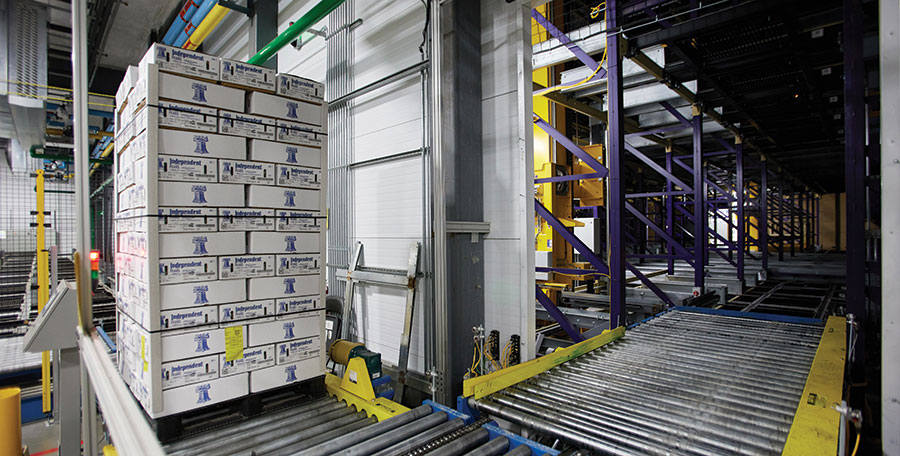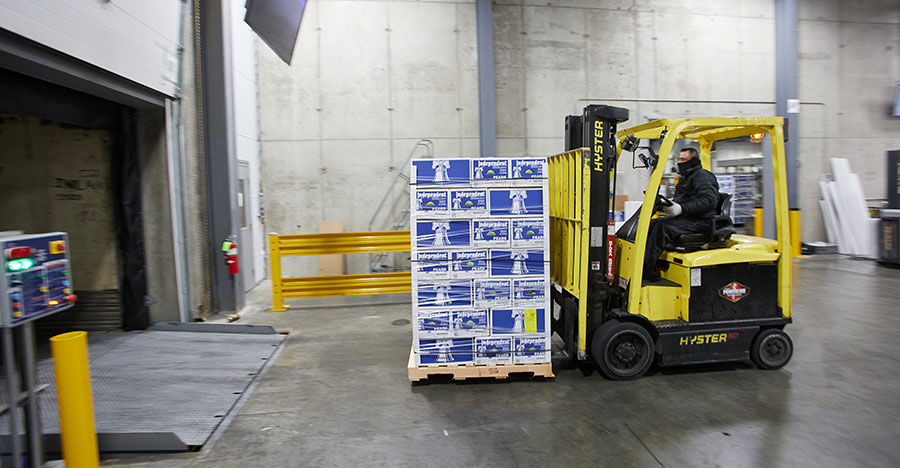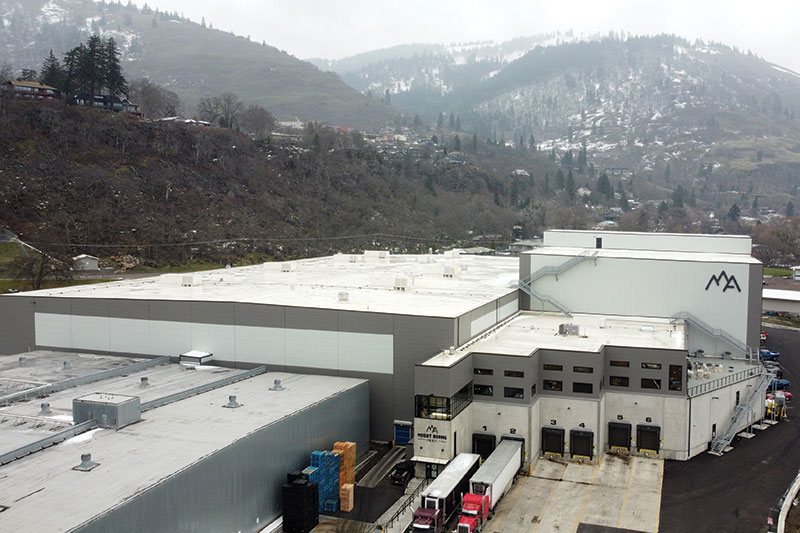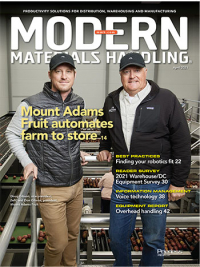Mount Adams Fruit automates farm to store
After a fire destroyed its warehouse, Mount Adams Fruit came back with one of the few automated facilities in the industry, including AS/RS and robotic palletizing.
Resilience and transformation have been two of the words used to describe leading supply chains in recent years, and especially during the pandemic. Often, they are applied to the industries that most of us interact with on a daily basis, such as retail, e-commerce fulfillment and grocery.
But they also apply to industries that fly under our radar; how often, for instance, do you think about what it takes to pack and deliver fresh pears, apples and cherries when you’re walking through the produce department at the grocery store?

Take an in-depth look inside the new distribution center.
With more than 2,000 acres of orchard under management in Oregon and Washington, Mount Adams Fruit illustrates both resilience and transformation in its operations from the farm to the store. Resilience because the company bounced back from a devastating fire in its distribution center in 2017. Transformational because the company is one of three packers in that segment of the fresh fruit industry to embrace automated storage, handling and palletizing technologies in its 250,000-square-foot facility for processing, packing and storing fresh fruit.
While automation is being adopted at the front end of the packing process, where fresh fruit is received, inspected and graded, Mount Adams is one of just three growers to automate warehousing; in this case, that involves palletizing with two modules of robotic palletizers—a total of six robots; automatic stretch-wrapping; and an automated storage and retrieval system (AS/RS) that uses a fleet of 18 shuttles, known as rovers, for horizontal travel (Advance Storage Automation). Three vertical reciprocating conveyors are used for vertical travel, rather than AS/RS cranes, to access seven levels of storage (Stocklin Logistik AG). Unless a packed carton needs to be re-inspected or re-packed, the system eliminates most manual handling from packing to loading on the shipping dock.
The AS/RS is accessed by a transfer car that automatically delivers pallets from stretch-wrapping to an induction station. From there, the rovers can travel in any direction on each of the seven storage levels, moving pallets among just less than 6,000 pallet positions, managing pallets like a storage-based Rubik’s Cube. The system can putaway 60 pallets an hour, while currently delivering 22 pallets an hour outbound with a capacity to handle 45 pallets per hour.

“We automated because we had a chance to start from scratch in a new facility, and there is a labor shortage in our area,” notes Doug Gibson, vice president of the family-owned operation. “But in addition to increased productivity, one of the extra returns on our investment is full control over our inventory. We now know where every pallet is located at all times.”
Combined with traceability capabilities that cover the journey of a lot of fruit from the tree to the packing box, Gibson says the company can now manage pallets not just on a first-in, first-out basis, “but we have the ability to quarantine, set fruit aside to pack or pull out a pallet that has already been packed to check for quality. Everything is in one data platform.”

Fresh fruit is packed by hand into cases. Those cases are then conveyed down to the floor level where they are palletized and stretch-wrapped for storage.
Bouncing back
Mount Adams Fruit was founded in 1909 as a family-owned orchard growing pears on 900 acres in the fertile volcanic soils between Mt. Adams and Mt. Hood in the Columbia River Gorge. Indeed, the new distribution center was built on a hillside on the banks of the river; with the Cascade Mountains in the background, it’s an unexpectedly picturesque setting for an industrial facility.
Today, the company grows its own fruit on more than 2,000 acres in the region—pears, apples and cherries are grown in different area locales to take advantage of slight changes in weather. The company also packs pears for more than 100 other growers in the area.
In addition to this Bingen facility, Mount Adams Fruit operates a separate facility in Dallesport, Wash., to pack cherries. According to Gibson, the company packs more than 1.5 million cases of cherries, 1.5 million cases of pears and about 500,000 cases of apples a year. In addition, Mount Adams Fruit partners with another apple grower that packs about 10 million cases a year. The company is managed by Gibson’s father, Don Gibson, who is president.
Their fruit is sold both directly and through brokers to all major retailers in North America selling fresh fruit, everyone from Walmart to Whole Foods. Between 20% and 40% of the product, depending on the fruit, is exported outside of North America and Mexico. For instance, a large share of the cherry crop is shipped to Asia.
Like other agricultural products picked fresh from the farm, the apple, pear and cherry business is seasonal. Cherries, for instance, are picked between June and August. Because they ripen and spoil faster than other fruit, they have to be picked, packed and shipped in 24 hours—Mount Adams Fruit will handle 20,000 tons of fruit during that brief window.

After pallets are stretchwrapped, they are delivered to an induction station by a transfer car.
Pears and apples have a different rhythm. What’s more, they can be stored in climate-controlled conditioning rooms that slow down or suspend the ripening process for months on end; apples, for instance, can be stored for 15 months. Pears can be stored and packed over a nine-month period. “In the controlled-atmosphere rooms, we can lower the temperature to the right temperature for that variety, then take all of the oxygen out of the room and store them with other products that block the ripening cells,” says Gibson. “That lets us suspend ripening until they’re ready to pack.” It’s not uncommon, he adds, to pack the previous year’s harvest of apples as the new crop arrives.
Doug Gibson joined the business in 2016. Previously, he had worked at several tech companies, and was investigating and implementing software technologies, such as Salesforce.com, which is not only the system of record for sales, but the repository for information collected about the inventory from the fields, such as spray records, global safety audits and lot information. “We do traceability from the orchard to the box of fruit that leaves the warehouse,” Gibson says.

Pallets ready for storage are inducted into the automated storage system, where they are moved by rovers.
But prior to 2017, most of Mount Adams Fruit’s warehousing operations were manual. Don Gibson had plans to automate. The grower owned land to build a new facility, with plans to phase in automation over the next 10 years. The Gibsons weren’t alone in that kind of timetable: While Mount Adams had implemented a visual inspection system on the front end of its operations, technology that was also being adopted by other packers. At that time, only two packers had implemented automated storage and retrieval: one using a conventional crane-based system from LTW and another utilizing Swisslog’s PowerStore pallet shuttle.
Then, early one morning in October of 2017, an electrical fire in the overnight shipping bathroom took down the packing line, the office and the shipping department. “It was the end of the harvest season, which is the busiest time of the year, and suddenly we had no packing or shipping departments,” Gibson remembers. The pear industry is friendly and cooperative. In short order, the Gibsons found four partners who were willing to pack and ship Mount Adams Fruits’ product using the Gibson’s labor. That 10-year timeline for a new facility became now. Resilience was paramount.
Bring in automation
Within two weeks of the fire, Don and Doug Gibson were in Europe looking at the latest in automated fruit packing equipment. “We didn’t have a lot of time to evaluate,” Gibson says.
At a high level, the Gibsons had four goals for the new facility.
- One was to get back operating as quickly as possible.
- A second was to automate where possible to increase capacity and address the labor shortage in the area. Automation would allow the company to concentrate labor in those areas where automation isn’t yet feasible, such as wrapping fresh pears in tissues and packing them in boxes. “We wanted the ability to increase our capacity by 40%. We will still need pear packers, but finding lift truck drivers and people to build pallets is a problem,” Gibson says. “To increase capacity, we had to automate.”
- A third was to implement a system to provide greater control over inventory once it was packed, palletized and put into storage. That would require a control system that would integrate with and complement Salesforce.com.
- And finally, the new facility needed to position the company at the leading edge in the industry for the next 20 years without another major investment in automation.
There weren’t many facilities to use as reference points. “Those two apple-packing plants were the only two that had taken the leap to automated storage,” Gibson says. “And, there were zero automated pear packing plants to look at.” He adds that when Mount Adams Fruit implemented the automatic vision system that is able to evaluate the interior and exterior of just picked fruit for imperfections that could impact freshness four years earlier, “we were at the cutting edge of pear packing.”
In addition to those two packing facilities, they visited Preferred Freezer’s automated facility handling frozen French fries in Richland, Wash., one of the largest automated freezer warehouses in the world (See “Preferred Freezer’s New Take on Automation” from the January 2018 issue of Modern).
Through a vendor, they learned about a new approach to automated pallet handling and multi-level storage. “When we met with them, they had no prior implementations other than a demo that they’d built for a pharmaceutical startup that we couldn’t visit,” Gibson recalls. But, the solution had a number of advantages over other automated storage technologies that appealed to Mount Adams Fruit.
For one, the system didn’t rely on conventional AS/RS cranes or elevators for vertical travel, instead using vertical reciprocating conveyors and rovers. The setup would require far less maintenance than a conventional crane-based system.
It also enabled redundancy. If one of the rovers went down, the rest of the fleet could continue working. The ability to move in multiple directions meant that a rover could easily access different work areas on different sides of the storage cube.
“We do a lot to our product before we ship it out,” says Gibson. “It may go back to quality control; the product may be repacked from boxes into bags and then go out the door or to a special storage area for repacked product; and we have different cooling and ripening areas depending on the fruit.”
The rack system, he adds, was simpler to install because it didn’t have to work with and support cranes. “You get the most density and efficiencies when you go vertical,” he says, “but it’s not necessary.”
The last piece of the puzzle was a warehouse control system that integrated with Salesforce.com to provide complete, real-time visibility into the state of product from the field, through processing, into storage and out to the customer. “That was the extra ROI that we didn’t appreciate until we began working with the system,” Gibson says.

Pallets are retrieved from the automated storage system and conveyed to a staging area in shipping. Then, they’re loaded onto an outbound trailer.
Going live
Construction on the new facility got underway in 2018. While the automated storage and retrieval system is the heart of the warehouse, the overall design involved more automation.
On the front-end, Mount Adams Fruit installed quality control and inspection lines from a Dutch manufacturer. Rollers rotate the fruit in multiple ways so cameras can take pictures from 360 degrees to size the fruit and identify defects. Through automation, Mount Adams is now using 12 associates in the sortation process, down from 36 in the old facility.
Fruit is automatically washed and dried. And, two multi-level conditioning rooms replaced four rooms using dated technology. Crews can perform multiple steps required before packing in one room rather than two, which allows for more control over temperatures and fresher fruit.
Once fruit has been packed by hand, a process that has yet to be automated, shipping cases are automatically palletized by one of six robotic palletizers. Each robot manages eight different SKUs. The robotic palletizers are programmed to allow the right amount of air space between cartons for air flow.
From there, corner boards are automatically applied before the pallets are automatically stretchwrapped. Finally, a transfer car picks up the pallets and delivers them to an induction station for the AS/RS, where they are picked up by a rover. Vertical reciprocating conveyors deliver the pallets to one of six storage levels above the floor. On the outbound side, pallets are delivered by the rovers to staging conveyor in shipping. It all happens with limited human intervention.
On Jan. 1, 2019, Mount Adams Fruit packed its first box of fruit with the new system. “We didn’t have walls in the facility yet, we were just starting to build the AS/RS and we kind of had a shipping dock,” says Gibson. “But, we had a packing line and were back in business.” By April 2019, the AS/RS was operational.
This represented a new level of automation and completely new ways of operating. There was a learning curve, but over the ensuing months, the company increased use of the system from 60% capacity to 85% capacity.
Nearly two years into using the system, Gibson says the most important measure is the turnaround time for loading an outbound truck. “It used to take us 40 minutes to load a truck,” he says. “We can now turn a truck around in under 20 minutes.”
And, how does it position Mount Adams Fruit for the future? “We planned the building to be a leader in the industry for the next 20 years without another major investment in automation,” Gibson says. “We’ve accomplished that. And, the control we now have over our inventory positions us for quality leadership.”

Article Topics
Automation News & Resources
Beckhoff USA opens new office in Austin, Texas ASME Foundation wins grant for technical workforce development Walmart chooses Swisslog AS/RS and software for third milk processing facility Lucas Watson appointed CSO for Körber’s Parcel Logistics business in North America 60 Seconds with Bob Trebilcock, outgoing executive editor, Modern Materials Handling Kathleen Phelps to join FORTNA as chief financial officer Coles automates grocery distribution in Australia More AutomationLatest in Materials Handling
Beckhoff USA opens new office in Austin, Texas Manhattan Associates selects TeamViewer as partner for warehouse vision picking ASME Foundation wins grant for technical workforce development The (Not So) Secret Weapons: How Key Cabinets and Asset Management Lockers Are Changing Supply Chain Operations MODEX C-Suite Interview with Harold Vanasse: The perfect blend of automation and sustainability Consultant and industry leader John M. Hill passes on at age 86 Registration open for Pack Expo International 2024 More Materials HandlingAbout the Author
Subscribe to Materials Handling Magazine

Find out what the world's most innovative companies are doing to improve productivity in their plants and distribution centers.
Start your FREE subscription today.
April 2024 Modern Materials Handling

Latest Resources












